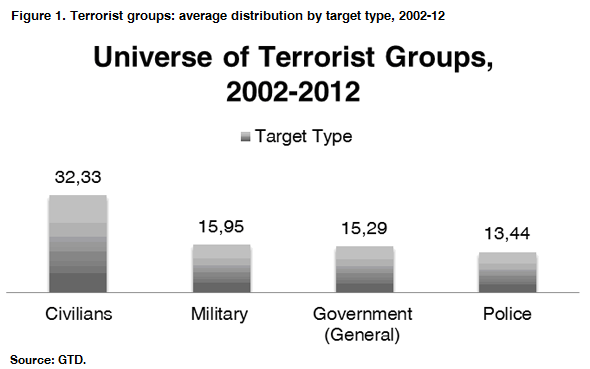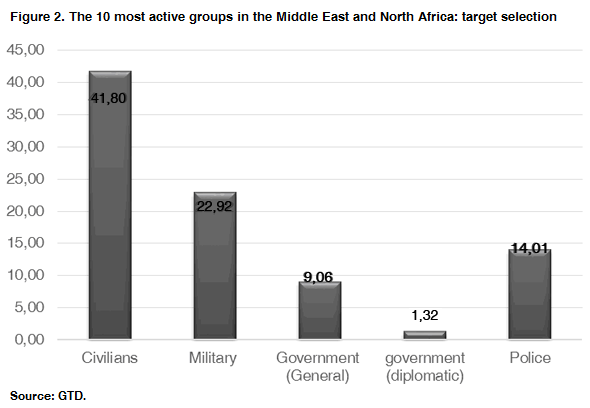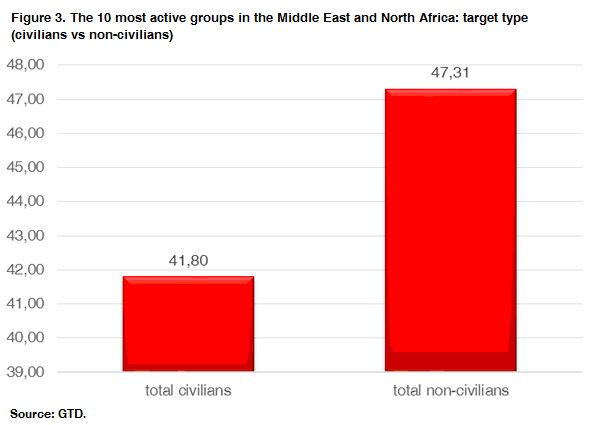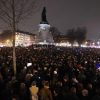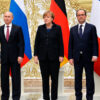
Theme[1]: Terrorist groups are generally distinguished from guerrilla organisations, but this distinction is gradually disappearing as a growing number of terrorist groups adopt guerrilla tactics. This study first offers some empirical evidence in support of this claim and then argues that in light of the growing divergence between terrorist and guerrilla organisations, most terrorist groups are better conceptualised as insurgent organisations. Such an approach can help analysts adopt a greater nuance in examining terrorist groups, leading to improved policies to stem the evolving threat of terrorism.
Summary: This paper first offers some empirical support to the idea that the vast majority of contemporary terrorist groups use a combination of terrorist and guerrilla tactics.[2] It then argues that these transformations would benefit from a growing reliance on concepts drawn from the insurgency and counterinsurgency literature on the part of analysts in order to fully appreciate the evolving nature of these groups. Finally, the study calls for increased correspondence and cross-fertilisation between terrorism studies and the scholarship on insurgency and counterinsurgency, as well as the literature on civil wars. We believe that such an interdisciplinary effort can offer a more lucid and dispassionate conceptualisation of these groups, of the full range of their activities and of the broader context in which they tend to operate. Such an approach, in turn, can improve policies to address the threat posed by these violent actors.
Analysis: In the summer of 2014, three prominent militant groups commonly classified as terrorist organisations engaged in significant combat operations that featured capabilities and tactics exceeding those traditionally ascribed to terrorist groups. These groups also achieved rare battlefield successes untypical of ordinary terrorist groups. The ‘Islamic State’ (IS, formerly the Islamic State of Iraq and Greater Syria, or ISIS) has been able to extend its stronghold and create an imposing presence over large swathes of territory in both Syria and Iraq, while threatening other neighbouring countries such as Jordan. The Lebanese Hizballah, dubbed by some analysts as ‘among the most skilled light infantry on the planet’,[3] continues to amass significant battlefield experience through its ongoing involvement in the Syrian civil war on behalf of the incumbent Alawite regime of Bashar al-Assad. Finally, in the Gaza Strip, the militant Islamist group Hamas has posed formidable challenges to Israeli military forces and civilians using a combination of terrorist and insurgent tactics. These trends also apply to other groups in broader geographical regions, including al-Qaeda. As a recent article by Jihadism scholar J.M. Berger argued, even al-Qaeda, broadly defined, is currently focused on fighting ‘wars and insurgencies’, while it conducts terrorism only ‘on the side’.[4]
This paper argues that the examples above indicate a broader transformation of terrorist groups into insurgent actors that increasingly combine the use of terrorist and guerrilla tactics.
Terrorism, guerrilla and insurgency
The existing scholarship on terrorism and its perpetrators suggests that terrorist groups differ from other militant actors such as guerrilla organisations. Terrorist groups and guerrilla organisations are said to differ, among other things, in their target selection. As Alex Schmid notes in his magisterial volume on terrorism research, ‘in the dominant understanding among experts, the victims [of terrorism] are predominantly not members of an armed force’.[5] Moreover, terrorist groups are generally considered to be smaller in size, while employing uncompromising violence. Conventional wisdom holds that the secret nature and small size of terrorist organisations generally prevents them from holding territory, while their focus on extreme violence prevents them from enjoying popular support.[6] Bruce Hoffman, for example, writes that terrorists do not function in the open as armed units, generally do not attempt to seize or hold territory, deliberately avoid engaging enemy military forces in combat, are constrained both numerically and logistically from undertaking concerted mass political mobilization efforts, and exercise no direct control or governance over a populace at either the local or the national level’.[7] Terrorist groups, in other words, are generally considered to have a modus operandi that differs from those of guerrilla groups.
A cursory look at contemporary ‘terrorist groups’, however, suggests that these groups regularly carry out guerrilla operations as well. In the existing literature, guerrilla attacks are said to typically emphasise extended campaigns of assassination, sabotage and hit-and-run attacks carried out by small and highly mobile paramilitary units. Like the tactics of terrorism, guerrilla warfare is described as a ‘weapon of the weak’ designed to harass the enemy and gradually erode his will. Yet where terrorism is in essence an act of psychological warfare –it hopes to turn the targeted population against its own government–, guerrilla operations primarily target their enemy’s capabilities.[8] Functioning as ‘small armies’, potent guerrilla forces are large and strong enough to seize and hold territory. Moreover, guerrilla tactics differ from terrorist tactics in terms of its main targets. While the prime targets of guerrilla fighters are the enemy’s armed forces, police or support units, as well as general government and economic targets, the targets of terrorist groups are usually understood to be civilians and, at most, non-combatants.[9]
Whereas terrorist groups have traditionally been treated as distinct from guerrilla organisations, many contemporary militant groups apply both terrorist and guerrilla tactics. As Robert Scales and Douglas Ollivant argue, a growing array of Islamist ‘terrorists’ have turned into ‘skilled soldiers’ who increasingly use a blend of traditional terrorist tactics and modern war-fighting techniques.[10] Contemporary militants continue to use terrorist tactics to intimidate potential supporters and enemies alike, but their modus operandi has evolved into skills that can pose considerable challenges to states and their populations. They now ‘maneuver in reasonably disciplined formations… and employ mortars and rockets in deadly barrages’. They rely on ambushes, roadside bombings, sniper fire and other tactics that in places such as Iraq and Afghanistan have imposed considerable challenges and losses to US forces. Groups such as the Islamic State, Hizballah and Hamas are able to handle second-generation weapons such as Russian RPG-29s and possibly wire-guided anti-tank missiles and build sophisticated underground tunnel systems.[11]
Empirical support for the growing terrorism-guerrilla nexus
One criterion by which to measure the growing crossover of terrorism and guerrilla tactics is to examine the choice of targets. Specifically, this analysis examines the targeting choices of groups defined as ‘terrorist groups’ by the Global Terrorism Database (GTD) of the University of Maryland, one of the most extensive and widely employed databases on terrorism. We examined all groups in the period between 2002 and 2012 that carried out at least six attacks –the minimum required to render the statistical analysis meaningful–.[12] 2012 is the last year for which data is available through the GTD, and we examined a period of more than 10 years because a shorter period would have significantly lowered the number of groups that would have reached the set minimum of six attacks. Furthermore, focusing on this time period allows for the analysis of contemporary militant actors, thereby rendering our study more policy relevant. These requirements left us with 119 groups to analyse. For each group we recorded the total number of attacks during that period and examined the distribution of target types, with a focus on attacks against civilians, general and diplomatic government targets, military targets and attacks against the police.[13] We expected a sizeable portion of the targets of these organisations to be military, government or police targets –a finding that would lend credence to our hypothesis that terrorist groups use guerrilla tactics as well–.
As the following analysis shows, the data strongly suggest that terrorist groups indeed use a combination of guerrilla and terrorist tactics. The analysis first focused on data for the universe of groups active in that decade. For these 119 groups, the average percentage of attacks against civilians is 32% (with a median of 28.6%). As Figure 1 shows, on average civilians are the favoured targets for these groups but such attacks account for no more than a third of the total. As much as 16% of the attacks were aimed at military targets, 15.3% against government targets and 13.4% against police targets. When combined, these targets generally considered typical for guerrilla operations –such as military, government and police targets– are targeted in 44.7% of the cases –a significantly higher figure than for civilians, the classic target of terrorism–.
We then conducted a more focused analysis on the target selection of ‘terrorist groups’ active in the Middle East and North Africa. In sum, groups active in the Middle East and North Africa are more likely to attack civilian targets compared with their counterparts in the other geographic locations combined. Still, attacks that could also be considered guerrilla attacks, ie, against military, police and government targets, outnumber attacks against civilian targets. The 10 most active groups labelled as terrorist groups by the GTD that operate in the Middle East and North Africa aim for non-civilian targets 47.3% of the time and civilian targets 41.8% of the time.
In conclusion, an empirical analysis strongly suggests that if terrorist attacks are defined as attacks against civilian targets only, the common labelling of these groups as ‘terrorist groups’ is, strictly speaking, only partially accurate.
Adopting concepts from insurgency and counterinsurgency theory
The trends emerging from our data analysis seem to suggest that what are commonly labelled ‘terrorist groups’ are in fact entities that engage in terrorism in addition to using other tactics. We argue that an existing concept, that of ‘insurgent group’, is most useful in describing this development.[14] The concept accounts for the generally observable interplay between violent and nonviolent (ie, political) means of struggle, for these groups’ reliance on either single or multiple tactics and for the fact that terrorism most often emerges in the context of a broader armed conflict such as a civil war.
The US Army/US Marine Corps Counterinsurgency Field Manual offers a definition of insurgency that synthesises the dominant view among insurgency and COIN theorists. It describes insurgency as ‘an organized, protracted politico-military struggle designed to weaken the control and legitimacy of an established government, occupying power, or other political authority while increasing insurgent control’.[15] Subversion and armed conflict –the interplay of political and violent means– are the two main ways in which insurgents seek to attain their goals. The concept of insurgency can help overcome the conceptual difficulties regarding the proper labelling of many contemporary militant groups because theorists of insurgency have long argued that insurgents typically rely on several modes of warfare at once. Although theoretically these modes of warfare do not have to include acts of terrorism –insurgents can rely, for example, on a combination of conventional and guerrilla tactics– they almost always do. Ariel Merari, for instance, observed that ‘whenever possible, insurgents use concurrently a variety of strategies of struggle. Terrorism, which is the easiest form of insurgency, is practically always one of these modes’.[16]
Viewing terrorist groups as insurgent groups should not be seen as an attempt to play down the fact that these groups frequently commit acts of indiscriminate violence. Yet it does help place these acts in a broader context of a more complex reality. Based on this understanding, even the most violent groups using the most despicable tactics are likely to spend most of their time and energy doing something other than killing civilians –fighting regular troops and government forces and subverting their enemies by means of propaganda and other political means–.
Of course, as the late terrorism scholar Paul Wilkinson noted, ‘it is possible to engage in acts of terrorism without mounting a full-scale insurgency’. [17] Self-standing campaigns of terrorism detached from broader conflicts, however, are becoming increasingly rare, and have always been the exception. According to Wilkinson, historically, acts of terrorism have been used as ‘part of a wider repertoire of struggle’.[18] Recent research on the interplay between terrorism and civil wars –the dominant type of warfare since World War II– confirms the ongoing relevance of Wilkinson’s assessment. According to data assembled and analysed by Michael Findley and Joseph K. Young, most incidents of terrorism ‘take place in the geographic regions where civil war is occurring and during the ongoing war’.[19] Civil wars are typically coded, inter alia, as wars between at least two parties, one of which is the government. The conduct of civil wars is therefore, by definition, marked by insurgency and counterinsurgency, again suggesting a close interrelationship between terrorism and insurgencies.
Conclusion: We believe that conceptualising of contemporary terrorist groups as ‘insurgent groups’ offers a far more nuanced approach that more accurately reflects reality on the ground. The approach helps acknowledge a number of important caveats: (1) terrorist groups use, almost without exception, terrorism in conjunction with other tactics, notably guerrilla warfare; (2) terrorist groups are becoming more sophisticated political actors, at times even striving to win over hearts and minds of local populations; and (3) terrorism is rarely a self-standing phenomenon as most terrorism occurs in the context of broader armed conflict, typically in cases of insurgency and/or civil war.
The analytical employment of the ‘insurgent group’ concept can contribute to a deeper theoretical understanding of the power distribution challenge that insurgent groups pose to governments by using terror. In addition, the suggested label can be useful in explaining the adoption of both violent (including terrorism) and nonviolent means of political struggle, based on the present political, economic and social conditions on the ground. Furthermore, the use of the label ‘insurgent groups’ allows a more comprehensive perspective on the dynamic relations between politically-motivated violent actors that use terrorism as a tactic, governments and other relevant actors. Finally, in terms of policy, the use of the suggested framework will provide a broader perspective of the insurgents’ political development, a better grasp of its network of contacts and supporters and it may also afford a considerable flexibility to policy decision-making.
Theoretically our conclusions also call for closer intellectual interaction between the terrorism and insurgency studies fields, as well as to the study of civil wars. Closer correspondence between these related fields can help shed more light on the political aspects of the campaigns in which terrorism occurs. Recognising that ‘terrorist’ violence, brutal and wanton as it is, cannot be divorced from these groups’ additional activities can assist in the formulation of better policies. Such policies should combine political and military components to address what is in essence a political-military threat. Finally, viewing terrorism as a phenomenon closely related to insurgency and civil war will allow analysts to pool the insights and best practices from academic fields that have thus far been treated separately. The study of terrorism, insurgency and civil wars not only suffer from a disconnect as far as the analysis of their causes are concerned: analyses of how these different phenomena might end are similarly compartmentalised. Insights from the study of the termination of civil wars and insurgencies, for example, are likely to inform future studies of the decline and demise of groups heavily reliant on terrorism, and vice versa.
Assaf Moghadam
Director of Academic Affairs, International Institute for Counter-Terrorism (ICT), Interdisciplinary Center (IDC), Herzliya
[1] The author is grateful to Ronit Berger and Polina Beliakova for research support.
[2] The targeting of civilians is generally considered a key aspect of terrorism. On this point, see especially Boaz Ganor (2005), The Counter-Terrorism Puzzle: A Guide for Decision Makers, Transaction Publishers, p. 1-24. Most scholars, however, expand that category of victims to civilians as well as noncombatants. See Alex P. Schmid (Ed.) (2013), The Routledge Handbook of Terrorism Research, Routledge, Oxford & New York, p. 39-157. For a recent discussion of guerrilla tactics targeting primarily government targets and armed forces, see Max Boot (2013), Invisible Armies: An Epic History of Guerrilla Warfare from Ancient Times to the Present, WW Norton & Company, p. xxii-xxiv. For a classic treatment of the topic, see Walter Laqueur (1976), Guerrilla Warfare: A Historical and Critical Study, Transaction Publishers.
[3] Robert H. Scales & Douglas Ollivant (2014), ‘Terrorist Armies Fight Smarter and Deadlier than Ever’, Washington Post, 1/VIII/2014, (accessed 6/VIII/2014).
[4] J.M. Berger (2014), ‘War on Error’, Foreign Policy, 5/II/2014, (accessed 24/VII/2014).
[5] Alex P. Schmid & Albert I. Jongman (1988), Political Terrorism. A Research Guide to Concepts, Theories, Databases and Literature, Transaction Publishers, Amsterdam & New Brunswick.
[6] See James Khalil (2013), ‘Know Your Enemy: On the Futility of Distinguishing between Terrorists and Insurgents’, Studies in Conflict and Terrorism, vol. 36, nr 5, p. 419-430. On a traditional description of terrorist groups, see Martha Crenshaw (1985), ‘An Organizational Approach to the Analysis of Political Terrorism’, Orbis-A Journal of World Affairs, vol. 29, nr, p. 465-489. See also Bruce Hoffman (2006), Inside Terrorism, Columbia University Press, chapter 1.
[7] Hoffman, op. cit., p. 35.
[8] For classic doctrinal formulations of guerrilla warfare, see Samuel B. Griffith (1978), Mao Tse-Tung on Guerrilla Warfare, Anchor Press; Guevara, Ernesto ‘Che’ (1998), Guerrilla Warfare, University of Nebraska Press, Lincoln; and Robert Taber (1970), The War of the Flea: A Study of Guerrilla Warfare Theory and Practice, Paladin, London.
[9] For a comparison of terrorism and guerrilla strategies, see Bard E. O’Neill (2005), Insurgency and Terrorism: From Revolution to Apocalypse, 2nd edition, Potomac Books, Washington DC; Laqueur (1976), op. cit.; Boot (2003), op. cit.; and Ariel Merari (1993), ‘Terrorism as a Strategy of Insurgency’, Terrorism and Political Violence, vol. 5, nr 4, p. 213-251.
[10] Scales & Ollivant (2014), op. cit.
[11] Scales & Ollivant (2014), ibid.
[12] The GTD database distinguishes between a large number of target types, but five of these were of particular significance to this project: civilians, diplomatic, government, military and police targets. We chose a minimum of six attacks because if a group listed in the GTD database attacked each one of the target types included in the database, setting six attacks as the minimum would ensure that at least one target type was targeted more than the others. A lower cut-off point would render the statistical analysis less meaningful.
[13] As stated earlier, the GTD provides information about many other target types-However, these are of less importance to this project. Additionally, we eventually excluded one of the target types –attacks on (diplomatic) government targets– from our charts and the final analysis as this type of target was rarely struck compared with the other target types, not used by most groups and lacked sufficient weight for an empirical analysis.
[14] We are not the first authors to do so. For similar arguments, see for example Merari (1993), op. cit.; David J. Kilcullen (2005), Journal of Strategic Studies, Vol. 28, nr 4, p. 597-617; and Khalil (2013), op. cit.
[15] US Department of the Army (2007), The US Army/Marine Corps Counterinsurgency Field Manual, US Army Field manual nr 3-24, Marine Corps Warfighting publication nr 3-33.5, University of Chicago Press. This definition is similar to the definition in other classic texts on insurgency. Compare, for example, O’Neill (2005), op. cit.; David Galula (1964), Counter-Insurgency Warfare: Theory and Practice, Frederick Praeger, New York, and John A. Nagl (2009), Learning to Eat Soup with a Knife: Counterinsurgency Lessons from Malaya and Vietnam, University of Chicago Press.
[16] Merari (1993), op. cit.. For a similar view, see also Kilcullen (2005), op. cit.
[17] Paul Wilkinson (2011), Terrorism versus Democracy: The Liberal State Response, 3rd edition, Routledge, Oxford & New York, p. 10.
[18] Wilkinson (2011), ibid.
[19] Michael G. Findley & Joseph K. Young (2012), ‘Terrorism and Civil War. A Spatial and Temporal Approach to a Conceptual Problem’, Perspectives on Politics, vol. 10, nr 2, 2012, p. 286.


